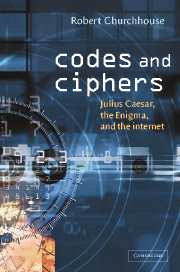Book contents
- Frontmatter
- Contents
- Preface
- 1 Introduction
- 2 From Julius Caesar to simple substitution
- 3 Polyalphabetic systems
- 4 Jigsaw ciphers
- 5 Two-letter ciphers
- 6 Codes
- 7 Ciphers for spies
- 8 Producing random numbers and letters
- 9 The Enigma cipher machine
- 10 The Hagelin cipher machine
- 11 Beyond the Enigma
- 12 Public key cryptography
- 13 Encipherment and the internet
- Appendix
- Solutions to problems
- References
- Name index
- Subject index
13 - Encipherment and the internet
Published online by Cambridge University Press: 13 August 2009
- Frontmatter
- Contents
- Preface
- 1 Introduction
- 2 From Julius Caesar to simple substitution
- 3 Polyalphabetic systems
- 4 Jigsaw ciphers
- 5 Two-letter ciphers
- 6 Codes
- 7 Ciphers for spies
- 8 Producing random numbers and letters
- 9 The Enigma cipher machine
- 10 The Hagelin cipher machine
- 11 Beyond the Enigma
- 12 Public key cryptography
- 13 Encipherment and the internet
- Appendix
- Solutions to problems
- References
- Name index
- Subject index
Summary
Generalisation of simple substitution
In a simple substitution cipher the letters of the alphabet are replaced by a permutation of themselves. We have seen that such a cipher is easily solved, given as few as 200 letters, by counting their frequencies and using knowledge of the language. To use such a cipher simply requires a 26-long table of the permuted alphabet. If, say, A was replaced by R, N by C and T by H then AN would become RC in the cipher and AT would become RH. Thus R, the substitution for A, would appear both times.
Since a simple substitution cipher replaces single letters by the same letter each time, irrespective of whatever letter precedes or follows them, the frequency count attack will ultimately succeed. To counteract this if we had a system where the encipherment of a letter depended on some of the letters on either side of it then AN might encipher to RC whereas AT might encipher to, say, KW and the monograph frequency count method would fail. Such a system could be based upon a substitution table which listed all 676 (=26×26) digraphs and their cipher equivalents. Effectively we would have a two-part code-book; the first part would list all 676 plaintext digraphs in alphabetical order on the left of the pages with their cipher equivalents listed opposite them on the right. The second part would list the 676 cipher digraphs in alphabetical order on the left with their plaintext equivalents on the right.
- Type
- Chapter
- Information
- Codes and CiphersJulius Caesar, the Enigma, and the Internet, pp. 170 - 189Publisher: Cambridge University PressPrint publication year: 2001



